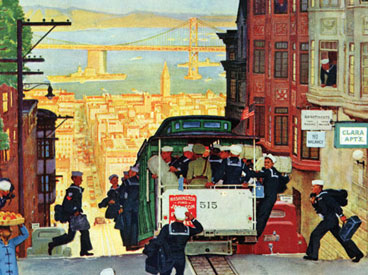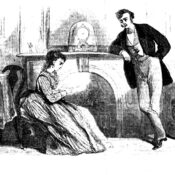In August of 1945, the city of San Francisco announced plans to dismantle its famous cable car system. The Post was in the thick of the uproar that followed. Mead Schaeffer’s September 29 cover helped “touch off an explosive burst of civic pride” that ultimately saved the cars, as writer Elmont Waite recounts in this article published five months later.
[See also: “The Looming Crisis in Mass Transit” from our Jul/Aug 2012 issue.]
February 9, 1946— “KOWFADAKUV!” echoes on in San Francisco, thanks to 1,349 assorted housewives, businessmen, writers, tourists, a Saturday Evening Post cover, and a sergeant sitting out on Iwo Jima. The city’s beloved antiques, those 1888-model cable cars, have beaten back the threat of civic progress. “Kowfadakuv!” which once sang past great-grandpa’s wind-whipped sideburns and which, of course, is English for the rule-book phrase, “Look out for the curve!” is now irretrievably immortal.
When progress recently reared its threatening head, there had been few improvements since Andrew Hallidie contrived the world’s first cable-car line in 1873 to scale the almost vertical San Francisco hillsides. Modern patrons seldom bother to glance inside that small part of each car which is enclosed with side walls and windows, for the accepted legend is that these spaces were filled with passengers at the factory when the cars were built. Most riders just plunk themselves on the benches, paralleling the track and facing out, that form the open front half of the cars, or they cling precariously outside on the step boards, like sardines hanging all over the outside of a can.
The crisis arrived last August. San Franciscans came face to face in their newspapers with the realization that they were about to lose the world’s first—and last—and indubitably most famous cable- car system. It was just that nobody seemed to want the job of running those half-pint cars any more. That, and the increasing laments of some of the clingers-on, who were beginning to assert that antiques ought to be kept in museums instead of in use.
The personnel problem looked insoluble. The utilities commission, which operates the city-owned part of the lines, feared that the conductors and gripmen (cable motormen) would be unable to resist better jobs on electric and bus lines, come September, when a general union sign-up for transportation employees was scheduled. The service, traditionally poor but spectacular, already was undermanned, and the city was forbidden by law to pay higher wages than comparable private industry. That was ninety-seven and a half cents, paid by the California Street Cable Railway Company, operator of the nonmunicipal section of the line, the only comparable industry in the world.
Then came sign-up day with its big surprise. Gripmen and conductors spat on their calloused hands and for some reason utterly unconnected with common sense stuck to their museum-piece jobs. Just one man deserted to an electric-line job—and darned if an electric-line man didn’t ask to replace him!
After that, spontaneously unfolded the project of curing the complaints of the chilled, soggy open-air riders. The women’s chamber of commerce sprang into a save-the-cable-cars campaign and Mead Schaeffer’s September 29 Post cover … helped touch off an explosive burst of civic pride. Housewives, businessmen, other letter writers from Corregidor to Peru, Indiana, expressed rage, shock, despair, disillusionment, and bitterness at the thought of San Francisco without a cable car. From Iwo Jima, Sgt. Martin Sugarman wrote to Chronicle Columnist Robert O’Brien, “Tear down the bay bridges, but leave our cable cars alone!” Fans offered money, offered to take the stump, offered to run the cars themselves. The riders quit complaining.
There was only one dissenter. A guest at a downtown hotel protested that the half-pint cars kept her awake. But she was a hopeless case. She lived in Los Angeles and didn’t even like foghorns.
Become a Saturday Evening Post member and enjoy unlimited access. Subscribe now



